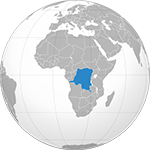Overview
A complex emergency has persisted in DRC for more than 20 years. Most displacement, which is frequent and repeated, is due to armed clashes and intercommunal violence between foreign, self-defence, and other armed groups. More than 5 million people are internally displaced and over 900,000 refugees from DRC live in African host countries. In addition, DRC also hosts about 527,000 refugees, mainly from Rwanda, CAR, and South Sudan.?
Since mid-October, DRC has been severely affected by flooding. As of 12 December, over 600,000 people are estimated to have been affected, around 40% of them are in Nord Ubangi (146,000 people affected) and Sud Ubangi (108,000 people).?
Since August 2018, DRC faces an outbreak of Ebola virus centred in Ituri and Nord-Kivu provinces. Conflict in Nord-Kivu makes the response extremely challenging, and activities are regularly suspended.?
In January 2019, the Commission électorale nationale indépendante announced the provisional results, with Félix Tshisekedi declared the new president, after elections took place on 30 December 2018 in a tense climate with reports of widespread irregularities, voter suppression, and violence. ?
INFORM measures DRC's risk of humanitarian crisis and disaster to be very high, at 7.6/10. Lack of coping capacity is of particular concern, at 8/10 as well as vulnerability at 7.6/10. ?
Latest Developments
A new Ebola outbreak was declared in the western province of Equateur on 1 June. The outbreak is mainly concentrated in the city of Mbandaka. Four fatalities were registered over 18-30 May. As of 2 June two more suspected and two more confirmed cases are reported. ?For more information on the outbreak, please see our latest report.
28/05/2020: Attacks against civilians have escalated in the eastern province of Ituri, starting from the end of 2019 and continuing into 2020. The government launched a military operation to dismantle armed groups, Lendu militias in this case, at the end of 2019. Between October and April almost 300 people were killed, 151 wounded, and 38 raped. Houses have been torched and health centres looted. Since January 2020 more than 250,000 people have been displaced to the provincial capital Bunia and other towns as villages and IDP camps were attacked. Basic services such as WASH, shelter, and NFIs are lacking in pre-existing informal and overcrowded camps in Ituri. Some humanitarian operations in Djugu, an epicentre of violence, have been suspended and humanitarian access remains extremely limited throughout the province, making it difficult to verify figures or provide aid.?
12/05/2020: Seven new Ebola cases, including four fatalities, have been confirmed in the Beni Health Zone, North Kivu province, as of 12 May. No confirmed cases had been reported for 52 days previous to 10 April and the government was about to announce the end of its tenth Ebola outbreak on 12 April. Small flare-ups towards the end of an Ebola outbreak are not uncommon and WHO assumes more cases might be identified. Response has focused on vaccinations and decontaminating buildings. Obstacles encountered by responders are related to limited funding, a simultaneous COVID-19 outbreak with 1,024 confirmed cases countrywide, and the local presence of armed groups. This latest Ebola outbreak caused 3,456 confirmed and probable infections and 2,276 deaths between 1 August 2018 and 10 April 2020.?
27/02/2020 For the first time since 1944, desert locusts have been reported in the DRC. The small group of mature locusts was sighted on the western shore of Lake Albert in eastern Congo on 21 February. An infestation with locusts could cause negative impact on food insecurity.?
13/02/2020 Militia attacks against civilians in Beni Territory (North Kivu) continue triggering population movements. Over 100,000 people are estimated to have been displaced across the territory since December. The most recent large displacement movement was from Mangina. Many IDPs face a lack of formal shelter and require basic assistance.?
ACAPS' team is daily monitoring the impact of COVID-19. Find more information related to the outbreak here.
Key Figures
INFORM Global Crisis Severity Index
Crisis Severity: 4.2
Impact: 4.7
Humanitarian Conditions: 4
Complexity: 4.3
Access Constraints: 4
Information courtesy of ACAPS. https://www.acaps.org/
| Title | Type | Theme | Attachment |
|---|---|---|---|
| Fire prevention in IDP sites - IEC material | Template | In-camp | |
| Fire prevention in IDP sites - IEC material | Template | In-camp |
| Title | Posted on |
|---|---|
| DRC - Humanitarian Dashboard - 1e Trimestre 2020 | 26 Jun 2020 |
| Manuel ERM RDC_mai-2020 | 26 Jun 2020 |
| Présentation et Utilisation de Kobo-ERM | 26 Jun 2020 |
| ERM outil de synthèse MdP (optionnel)_20200430 | 26 Jun 2020 |
| ERM Outil d'analyse et rapportage_20200522 (version… | 26 Jun 2020 |
24 Common Operating Datasets or CCCM-tagged datsets are on the Humanitarian Data Exchange:
- Democratic Republic of the Congo - Internally displaced persons - IDPs - IDMC - 01/01/2008-12/31/2019
- DRC Displacement Data - North Kivu Province - Baseline Assessment [IOM DTM] - International Organization for Migration - 09/15/2019-10/12/2019
- DRC Displacement Data - Tanganyika Province - Baseline Assessment [IOM DTM] - International Organization for Migration - 09/16/2019-10/12/2019
- DRC Displacement Data - Ituri Province - Baseline Assessment [IOM DTM] - International Organization for Migration - 09/15/2019-10/12/2019
- DRC Displacement Data - Kasai Oriental Province - Baseline Assessment [IOM DTM] - International Organization for Migration - 02/01/2019-02/16/2019
- DRC Displacement Data - Kasai Province - Baseline Assessment [IOM DTM] - International Organization for Migration - 02/01/2019-02/19/2019
- DRC Displacement Data - Kasai Central Province - Baseline Assessment [IOM DTM] - International Organization for Migration - 02/03/2019-02/24/2019
- DRC Displacement Data - Sankuru Province - Baseline Assessment [IOM DTM] - International Organization for Migration - 08/31/2018

